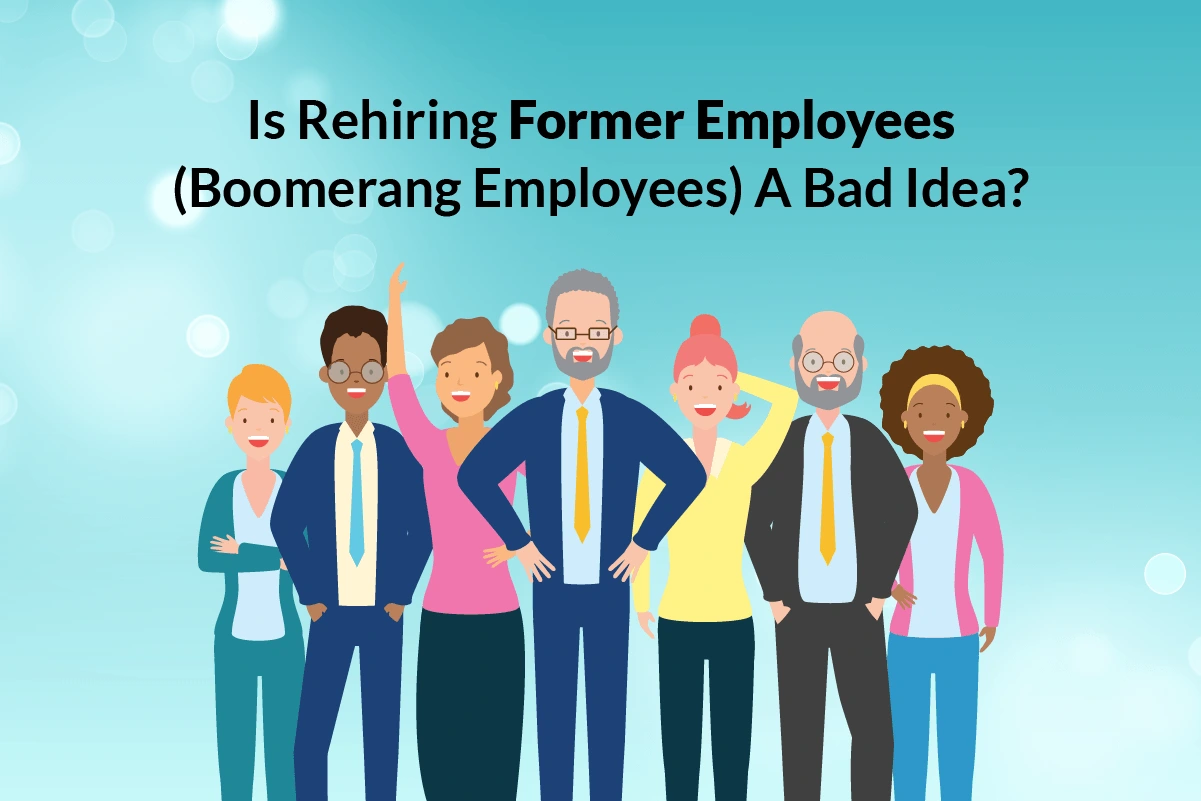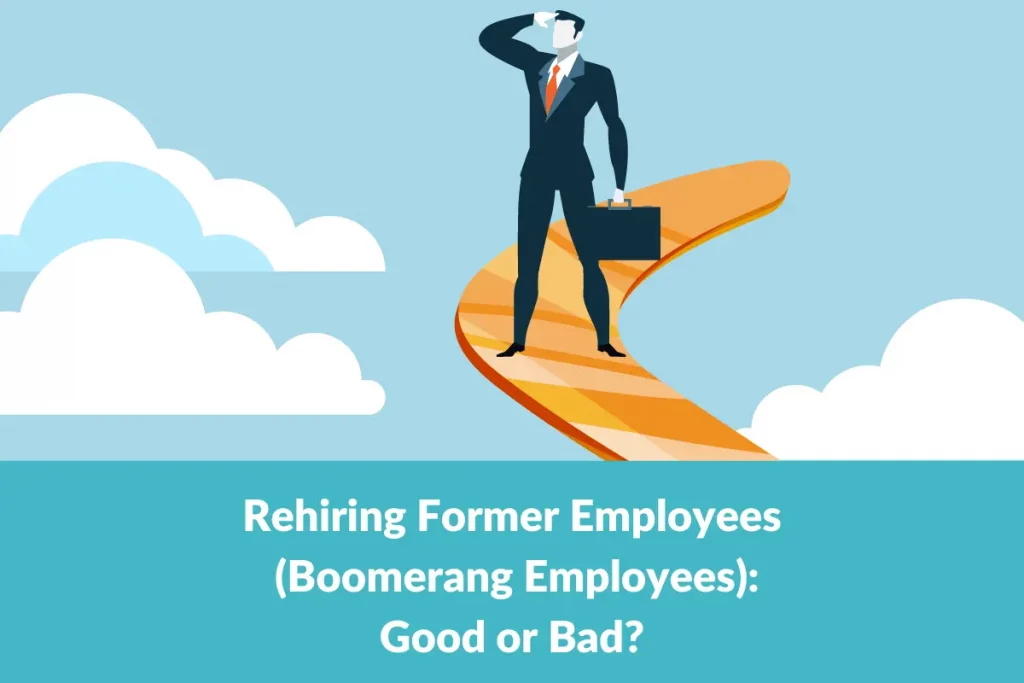When it comes to filling one or more open positions, many employers consider rehiring former employees. Employees who return to their former employers are also known as “boomerang” employees.
These employees already know the organization’s outs, ins, and nuances and understand the employer’s expectations and company culture. So hiring them seems like a good idea. But it also has risks. Keep reading to see more!
What Is a Boomerang Employee?
Boomerang employees are someone who has left their jobs at an organization but now return and are rehired by the former employer. Many people think that this term only involves employees returning to a workplace where colleagues are still familiar with them.
The rehiring may happen years or months after these employees leave their jobs.
In some circumstances, boomerang employees can leave and return regularly. For example, employees who attend school full-time can go back to the workplace and be rehired after the school year finishes.
Here are some main reasons professionals leave a current position:
- Perhaps the company culture is not what they thought it would be.
- The role is different from what is advertised.
- There are fewer chances for career advancement.
- The benefits and salary are not ideal.
- Pursue a passion.
- Further their career at other companies.
- Endure significant life changes.
- Work seasonally (especially common in the retail and hospitality industries).
Pros and Cons of Rehiring Former Employees
Before rehiring former employees who quit, it is best to consider the positive and negative effects.
Pros
- Existing relationships: Provided the relationships are positive, the rehired employee has a leg up when talking about communication and collaboration.
- Familiarity with your company’s culture: Former employees should know what they are getting regarding company culture, coworkers, and traditions.
- Low training costs: Former members may need short refresher sessions on main equipment and technologies.
- Fast hiring and onboarding: You will spend less money and time on recruiting, interviewing, and introducing the repeating employee into the working environment.
- New perspectives and skills: If the former employee has taken on other jobs when leaving the company, they will bring various new experiences, viewpoints, and ideas to the table. As they already know your organization, they may already hold ideas for innovation and implementation.
- Enthusiasm: Having taken some time away, the boomerang employee typically returns to their old organization and role with enthusiasm and renewed energy.
Cons
- Complacency: Unlike new hires that typically are eager to impress, former ones may feel less motivated to work as they already went through the hiring and training process.
- Likely to resign again: As the former employee has already quit the company once, it may be possible for them to leave again when they find a more enticing opportunity.
- Potential for bad feelings: If the former employee left or was laid off under unpleasant circumstances, there is a high chance they are holding on to resentment.
- Hard to adjust: Adjusting to changes in your company may be hard, especially for a long-term former employee.
- Fraught relationships: When a former employee returns, old interpersonal problems with other team members may arise. Promotions can also form stress, especially if the returning member will be reporting to a former subordinate.
Tips for Rehiring Former Employees
If you decide to rehire a previous employee, here are some tips to help increase the opportunities for a successful rehire.
Assess Current Abilities And Needs
Things may have changed at your organization since the employee left. Before contacting a former employee, it is essential to take the time to get to know your current needs appropriately. Then, you can decide whether this person is a good fit.
Make an Honest Conversation
Once you decide that a boomerang employee will be valuable to your company, it is time to have a conversation. Just sit down together and discuss some topics, such as:
- Main reasons this employee left.
- Motivation for their return.
- Hesitation on both sides.
- The interim experience.
That conversation is an ideal time to get everything out in the open. It is not necessary to jump to conclusions immediately. Instead, it enables a cooling-off period before deciding if you want to move forward.
Consider Your Current Team
The return of boomerang employees will impact group dynamics. Therefore, you should bring your current team members into the discussion, let them know about your rehiring, and ask for their opinions.
Pay special attention to strong positive and negative reactions. If most of your team agrees with the decision, then the former employee will be able to have a smooth transition.
Conduct an Interview
Once the majority of your team agrees to rehire a former employee, it is time to move forward with an interview. It doesn’t necessarily look like a structured interview, but it is ultimately a valuable opportunity for the two parties to dig into vital details.
Start this interview by setting expectations. Discuss them and how they relate to the new role, and explain how it fits into the company.
Then, talk about all changes at your company. Explain the new technologies and systems that will affect the employee. The same should go for shifts in vision, mission, and clients. If your company was restructured, discussing how it can impact the person’s career path is essential.
This time also gives former employees a realistic picture of the environment they will experience. If both parties are happy to proceed, discuss their expectations.
Explore what they want to feel satisfied and confident in the new position. If this employee returns with new skills and experience, they will probably request a better job title with a higher salary.
Agree on Practicalities
The job offer negotiation is the last obstacle in rehiring former employees. It can be a challenging process, especially if you are no longer in a position to match this employee’s old benefits package and salary.
It is unnecessarily a deal-breaker. Just explain the current financial situation and projections for the future. When discussing the terms of employment, ensure a clear idea about the following:
- Promotion schedule as well as advancement opportunities.
- Alternative perks to make up for non-negotiable pay cuts.
- Specific responsibilities and conditions of the new job.
Honesty is the most effective way to minimize surprises down the line.
Keep a Talent Pool
A talent pool refers to keeping in contact with former employees, including interns, contract workers, former employees, and more. It will give you a chance to use a professional from the talent pool whenever open positions are available.
Keeping a talent pool can make the rehiring process much more effortless and allow former employees to reach out for new opportunities. The talent pool can help your firm save money, time, and resources on recruitment processes and enable you to maintain a network of talented professionals.
Conclusion: Is Rehiring Former Employees a Bad Idea?
A boomerang employee may be primed to enter your workplace quickly. As we discussed above, hiring such employees benefits more than is harmful.
Given you offer proper onboarding & training and know why this employee has left your organization, rehiring them can be a win-win situation for both the boomerang employee and your organization.





